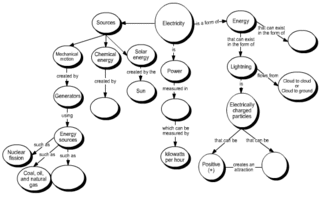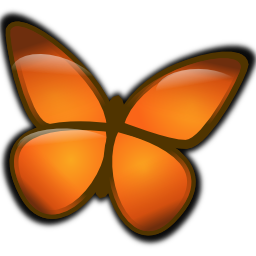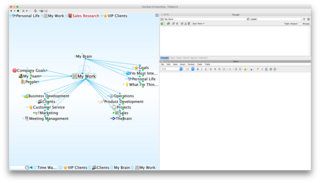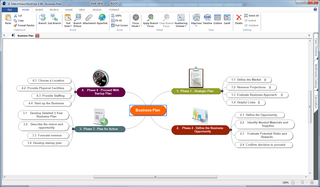Related Research Articles

A mind map is a diagram used to visually organize information into a hierarchy, showing relationships among pieces of the whole. It is often based on a single concept, drawn as an image in the center of a blank page, to which associated representations of ideas such as images, words and parts of words are added. Major ideas are connected directly to the central concept, and other ideas branch out from those major ideas.

Anthony Peter "Tony" Buzan was an English author and educational consultant.

Functional neuroimaging is the use of neuroimaging technology to measure an aspect of brain function, often with a view to understanding the relationship between activity in certain brain areas and specific mental functions. It is primarily used as a research tool in cognitive neuroscience, cognitive psychology, neuropsychology, and social neuroscience.

A concept map or conceptual diagram is a diagram that depicts suggested relationships between concepts. Concept maps may be used by instructional designers, engineers, technical writers, and others to organize and structure knowledge.

FreeMind is a free mind mapping application written in Java, which is further developed by the fork Freeplane. FreeMind itself was last updated in 2014. FreeMind is licensed under the GNU General Public License Version 2. It provides extensive export capabilities. It runs on Microsoft Windows, Linux, and macOS via the Java Runtime Environment.

Note-taking is the practice of recording information from different sources and platforms. By taking notes, the writer records the essence of the information, freeing their mind from having to recall everything. Notes are commonly drawn from a transient source, such as an oral discussion at a meeting, or a lecture, in which case the notes may be the only record of the event. Since the advent of writing and literacy, notes traditionally were almost always handwritten, but the introduction of notetaking software has made digital notetaking possible and widespread. Note-taking is a foundational skill in personal knowledge management.
A GIS software program is a computer program to support the use of a geographic information system, providing the ability to create, store, manage, query, analyze, and visualize geographic data, that is, data representing phenomena for which location is important. The GIS software industry encompasses a broad range of commercial and open-source products that provide some or all of these capabilities within various information technology architectures.
Neurophilosophy or the philosophy of neuroscience is the interdisciplinary study of neuroscience and philosophy that explores the relevance of neuroscientific studies to the arguments traditionally categorized as philosophy of mind. The philosophy of neuroscience attempts to clarify neuroscientific methods and results using the conceptual rigor and methods of philosophy of science.

Web mapping or an online mapping is the process of using, creating, and distributing maps on the World Wide Web, usually through the use of Web geographic information systems. A web map or an online map is both served and consumed, thus, web mapping is more than just web cartography, it is a service where consumers may choose what the map will show.

MindManager is a commercial mind mapping software application developed by Mindjet. The software provides ways for users to visualize information in mind maps and flowcharts. MindManager can be used to manage projects, organize information, and for brainstorming.

Xmind is a mind mapping and brainstorming software, It is developed by Xmind Ltd., a company registered in Hong Kong, and first released in 2007. The application can be used to visualize ideas, clarify thoughts, manage complex information, and promote team collaboration. People use Xmind to improve their productivity and creativity while working or learning. As of April 2013, Xmind was selected as the most popular mind mapping software on Lifehacker.
Tinderbox is a personal content management system and personal knowledge base.

3D Topicscape is a Personal information manager that provides a template loosely based on mind-mapping or concept mapping. It presents the mind map as a 3D scene where each node is a cone. It can also display in a 2D format. Nodes are arranged in a way that indicates how they are related in much the same way as a mind map. In addition to its use for information management it is claimed to be suitable as a task manager, and for use in project management.

TheBrain Technologies is a software company located in Los Angeles, California. Founded in 1998, they specialize in a Knowledge Graph type of mind mapping software.
MindMapper is a mind mapping software and mental organization tool developed by SimTech Systems. It allows users to create a mind map from thoughts in the brain and convert it into software programs such as Word, PowerPoint, or Hangul Office. As of 2020, the software was used by more than 10,000 organizations and companies in 96 countries.

Mindomo is a versatile freemium collaborative mind mapping, concept mapping and outlining tool developed by Expert Software Applications. It can be used to develop ideas and interactively brainstorm, with features including sharing, collaboration, task management, presentation and interactive web publication.

MindMeister is an online mind mapping application that allows its users to visualize, share and present their thoughts via the cloud. MindMeister was launched in 2007 by MeisterLabs GmbH, a software company founded by Michael Hollauf and Till Vollmer. After 10 years in the market, MindMeister has more than 7 million users who created more than a billion ideas to date.
ConceptDraw MINDMAP is proprietary mind mapping and brainstorming software developed by CS Odessa for Microsoft Windows and Apple macOS operating systems.

MindView is a mind mapping and project management software owned by the company MatchWare. MindView is used for mind mapping, concept mapping, work breakdown structures, timelines, Gantt charts, organizational charts, and other visuals.